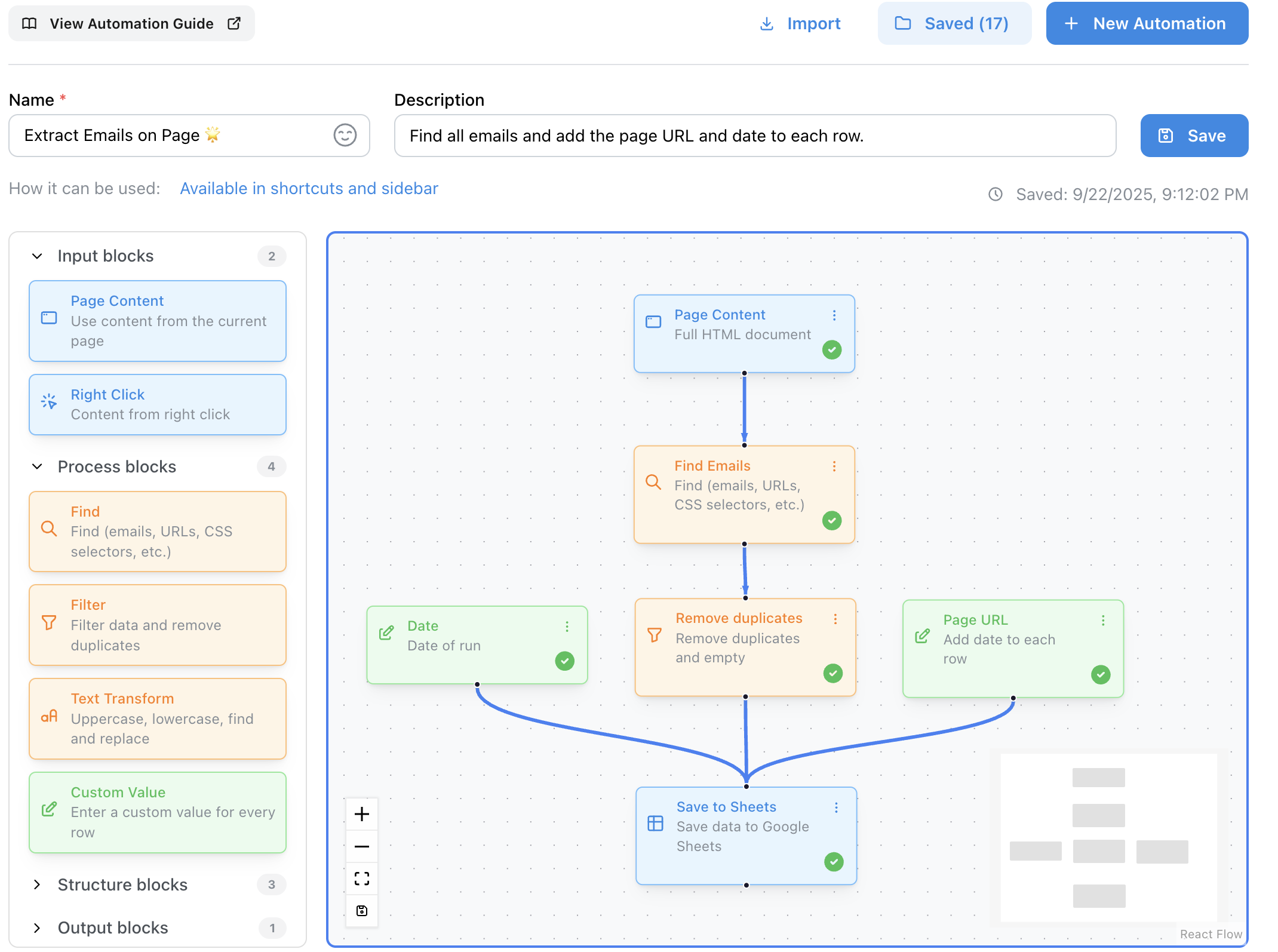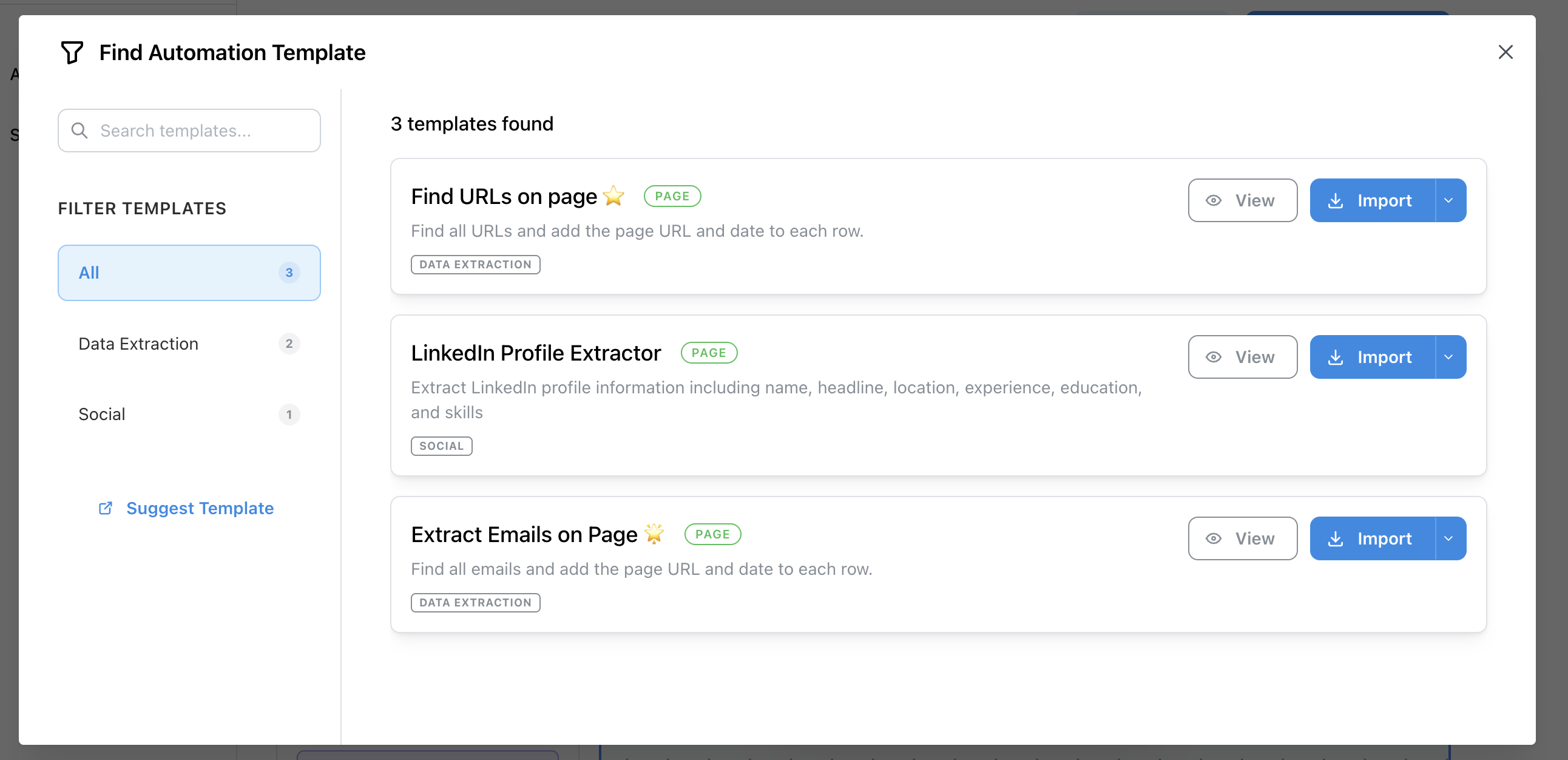No-code Automations: Build Data Workflows Without Writing Code
I’m excited to introduce No-code Automations - a new feature in Add to Sheets that lets you build data processing workflows using a visual, drag-and-drop interface. No coding experience required!
What are No-code Automations?
No-code Automations are visual workflows that automatically extract, process, and save data from websites to your Google Sheets. Think of it like building with building blocks - each block has a specific purpose, and you connect them together to create data processing workflows.

Instead of manually copying and pasting data from websites, you can create automations that do this work for you. Once set up, these automations can run with a single click or keyboard shortcut, saving you hours of repetitive work.
Watch how easy it is to set up and use automations:
To start creating your own Automation workflows, access the Automation builder by clicking Automations option in the extension account dropdown menu.
Or, by clicking on the Automations tab in the extension.


Stop Wasting Hours on Manual Data Entry
Create Complete Rows from Different Parts of a Webpage
Instead of manually copying a product name from one section, the price from another, and the description from a third section, automations can extract all this information and organize it into a single row in your Google Sheets. No more switching between different parts of a page or trying to remember what goes where.
Fast Execution with Keyboard Shortcuts
Set up custom keyboard shortcuts to trigger your automations instantly. No need to right-click, navigate menus, or switch between tabs. Just press your shortcut key and the data is collected and saved automatically.
Works with the Page You’re Already Browsing
Automations use the data from the webpage you’re currently viewing. You don’t need to provide login credentials, make separate requests, or worry about API limits. Everything happens in your browser using the content that’s already loaded.
Flexible and Adaptable to Website Changes
Websites change their layouts frequently, but automations are designed to be flexible. You can easily modify your automation when a website updates its structure, without starting from scratch. The visual interface makes it simple to adjust which parts of the page to extract data from.
When websites change their HTML structure, you can capture these changes quickly using the Find block by updating your CSS selectors to target the new elements. Our CSS Selector Reference provides guidance on all available selectors to help you adapt to these changes quickly.
Reduces Copying and Pasting
Data goes directly from the webpage to your Google Sheets. No more copying text, switching tabs, pasting into cells, and trying to keep everything organized. The automation handles the entire process automatically.
Keeps Your Data Private
All data processing happens in your browser. The information never leaves your computer until it’s sent directly to your Google Sheets. No third-party servers, no data sharing, no privacy concerns.
How Automations Work
Automations are built using different types of “blocks” that you connect together:
| Block Type | Purpose | Available Blocks |
|---|---|---|
| Input Blocks | Where Data Comes From | Page Content: Extract data from entire webpage (HTML) Right-Click: Process selected text, links, or image URLs |
| Process Blocks | What Happens to the Data | Find: Extract patterns like emails, headings, CSS selectors Filter: Remove duplicates or unwanted data Text Transform: Clean and format text Custom Value: Add static info like dates or page URLs |
| Structure Blocks | How Data is Organized | Split: Break text into separate items Combine: Merge items together Table: Extract structured table data |
| Output Blocks | Where Data Goes | Save to Sheets: Send processed data to your Google Sheets |
How to Run Your Automations
Once you’ve created an automation, you can run it in different ways depending on the type:
- Page Content Automations: Run using keyboard shortcuts or from the extension side panel

- Right-Click Automations: Available in the right-click context menu when you select text or elements on a webpage
This makes it easy to integrate automations into your existing workflow, whether you prefer keyboard shortcuts or mouse-based interactions. For more details on setting up keyboard shortcuts, check out our keyboard shortcuts guide.
Getting Started with Your First Automation
Let’s walk through creating a simple automation that extracts email addresses from a webpage and saves them to Google Sheets.
Step 1: Open the Automation Builder
- Open the Add to Sheets extension
- Click on the “Automations” tab
- Click “New Automation” to open the visual builder
- You’ll see a canvas with a sidebar of available blocks
Step 2: Add Input Block
- Drag a “Page Content” block from the Input section
- Configure the Page Content block:
- Select “Body HTML” from the content type dropdown
- This will extract the main content from the webpage (excluding head section)
- The block will automatically be placed on your canvas
Step 3: Add Processing Blocks
- Drag a “Find” block from the Process section
- Connect it to your Page Content block (drag from the output dot to the input dot)
- Configure the Find block:
- Select “Email addresses” from the pattern dropdown
- This will automatically find all email addresses on the page
- Drag a “Filter” block from the Process section
- Connect it to your Find block
- Configure the Filter to remove duplicates
Step 4: Add Output Block
- Drag a “Save to Sheets” block from the Output section
- Connect it to your Filter block
- Configure the Save to Sheets block:
- Select your Google Sheets spreadsheet
- Choose the sheet within the spreadsheet
- Map the email data to Column A
Step 5: Test Your Automation
- Click “Save” to save your automation
- Give it a name like “Extract Contact Emails”
- Visit a webpage with email addresses
- Run your automation using:
- Keyboard shortcut (if you’ve set one up)
- Side panel (for page content automations)
- Check your Google Sheets to see the extracted emails
Pro Tips for Your First Automation
- Start Simple: Begin with basic email extraction before trying complex patterns
- Test on Different Pages: Make sure your automation works on various websites
- Use Templates: Browse the template library for pre-built automations you can customize
- Check Your Data: Always review the results in Google Sheets to ensure accuracy
For a complete guide to all available blocks and advanced features, visit our Automations page.
Real-World Examples
Here are common scenarios where automations solve specific problems:
| Use Case | Problem | Solution |
|---|---|---|
| Lead Generation | Manually copying contact info from business directories takes forever | Extract all contact info and organize into Name, Email, Phone, Company columns |
| Product Research | Copying product details from e-commerce sites is time-consuming and error-prone | Extract product details and save in consistent format to comparison spreadsheet |
| Content Aggregation | Manually copying article titles, authors, and dates is tedious | Extract article metadata and save to content tracking spreadsheet with keyboard shortcut |
| Competitive Analysis | Manually checking and recording competitor pricing is repetitive | Extract pricing and feature info from competitor websites automatically |
| Event Management | Manually entering attendee details is slow and error-prone | Extract attendee info from registration pages and LinkedIn profiles |
Templates: Jumpstart Your Automations
Don’t want to build from scratch? We’re in the process of creating automation templates for common use cases:
- Email Extraction: Find all email addresses on a page
- Link Collection: Gather all links from a webpage
- Contact Information: Extract names, emails, and phone numbers
- Article Metadata: Collect titles, authors, and publication dates
You can import these templates and customize them for your specific needs.

👋 Have an Idea for a Template?
We’re always looking for new automation templates that would be helpful to our community. If you have an idea for a useful automation template, let us know!
When to Use Automations vs. Regular Saving
Use Regular Right-Click Saving when:
- You need to save individual pieces of content that are different each time
- You want to review and select specific content before saving
- You’re working with one-off data that doesn’t follow a pattern
Use Automations when:
- You find yourself copying the same type of information repeatedly from similar pages
- You need to extract data from different parts of a webpage and organize it into complete rows
- You want to eliminate the manual work of organizing data into spreadsheet rows
- You’re doing bulk data collection that would otherwise take hours of manual work
- You need to extract data and populate spreadsheet templates automatically
- You need to process and clean data before saving it to your spreadsheet
Ready to Get Started?
No-code Automations are available now in Add to Sheets as part of the Automations plan. If you’re already using Add to Sheets for regular saving, automations solve the problem of repetitive, time-consuming data collection tasks.
Whether you’re a small business owner tired of manually copying contact information, a researcher overwhelmed by data collection, or just someone who wants to eliminate the tedious work of organizing data into spreadsheets, no-code automations can help.
Ready to try no-code automations? Install or update Add to Sheets and start building your first automation today.
Have questions or feedback about automations? We’d love to hear from you at [email protected] or on Threads.